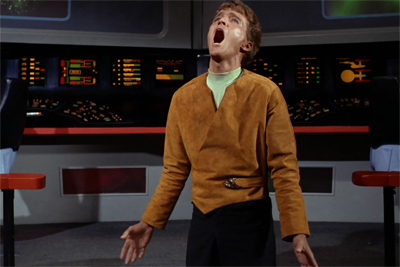To celebrate the release of Star Trek: Into Darkness this month, we’ll be running through the first season of the classic Star Trek all this month. Check back daily to get ready to boldly go. It’s only logical.
We’ll be supplementing our coverage of the episodes with some additional materials – mainly novels and comics and films. This is one such entry.
The classic Star Trek was not really a character-driven show. Of course, everybody recognises Kirk, Spock and McCoy, but the show seldom took the time to really dig into their history or origins. We’d occasionally find out that Kirk had some overlap with the villain of the week. He had served on a starship that had been the victim of a vampire space cloud, or lived on a colony during a brutal massacre. These details added up to something, along with the occasional reference to (and eventual death of) his brother Sam.
Spock got a bit more development, probably due to the fact that he was an alien. After all, developing Spock meant developing an entire exotic alien species, and offered some insight into how Vulcans must live. We’d also get occasional factoids or tidbits (Vulcans can mind meld, they have inner eyes, they had a schism millennia ago) that help to give a concrete picture of the where the character came from and where he might like to go.
McCoy, on the other hand, was a bit of a blank slate. Everybody knows McCoy. He’s the irritable surgeon on the ship, prone to insulting Spock and complaining about the fact that he’s flying through space in a ship filled with mechanical doo-hickeys. However, we never really get a sense of McCoy’s past. We never learn much about his family on-screen, except when the writers wanted a bit of dramatic fodder in the penultimate movie featuring the original cast, Star Trek V: The Final Frontier. But we don’t talk about that.
So David R. George III’s Crucible: McCoy – Provenance of Shadows is an interesting book. Not only because it is a book completely devoted to the least-developed of the iconic leading trio, but also because this relatively under-developed character also gets one of the longest Star Trek tie-in books ever written. And without too much focus on his past.
Filed under: The Original Series | Tagged: Atlanta, DeForest Kelley, DeForestKelley, gene roddenberry, james t. kirk, kirk, Leonard McCoy, McCoy, Roddenberry, spock, Star Trek Original Series, Star Trek V: The Final Frontier, star trek: the next generation, StarTrek, Way to Eden | Leave a comment »























